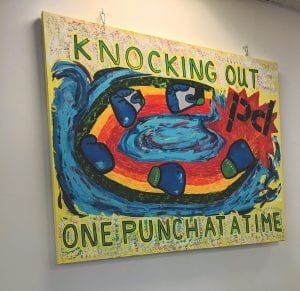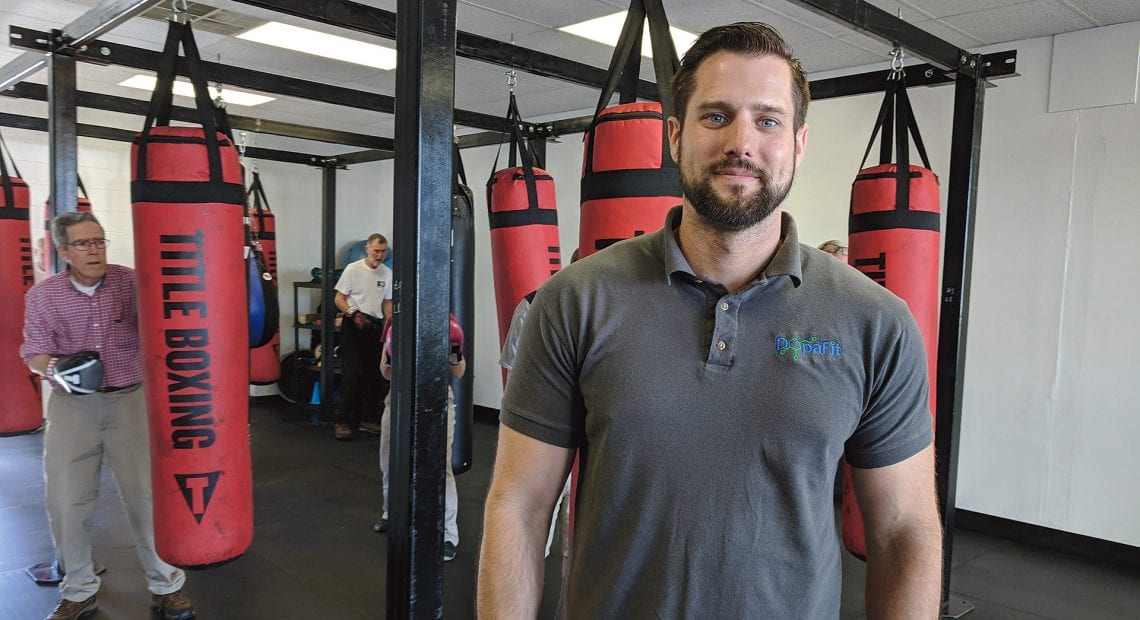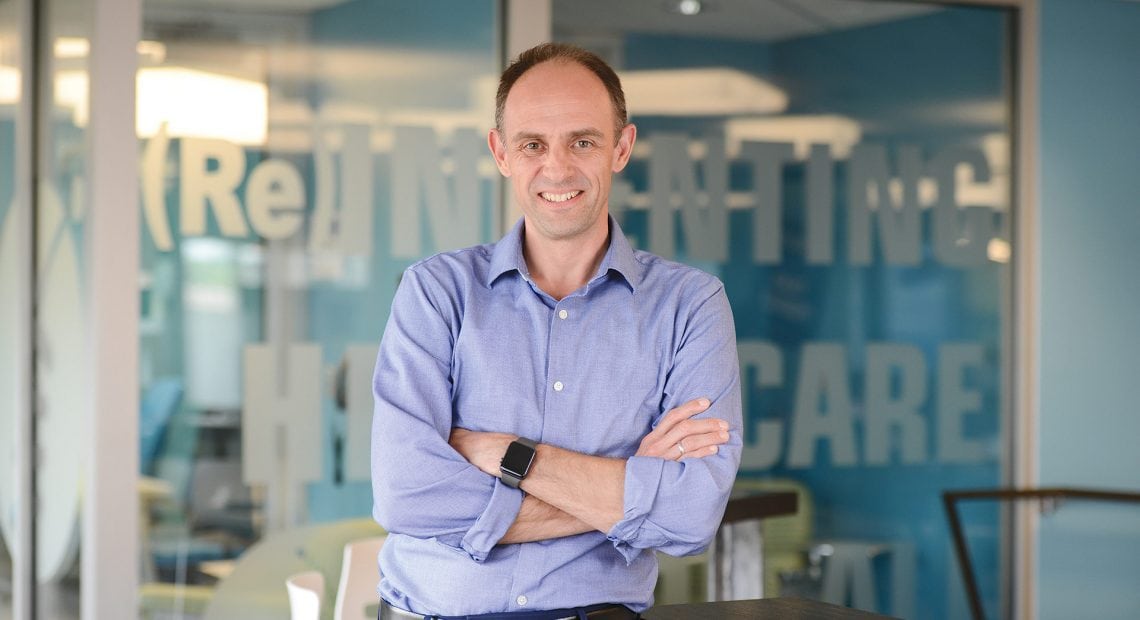The Power of Movement

Chad Moir turned his resentment against Parkinson’s disease into a chance to help others fighting the disease that took his mother.
As they don boxing gloves and pound away, with various levels of force, at punching bags suspended from the ceiling, the late-morning crowd at this Southampton gym looks a lot like a group exercise class at a typical fitness center.
Except that most of them are older than the usual gym crowd. Oh, and all of them are battling Parkinson’s disease.
“A lot of them have never boxed before in their lives, and now they get to put on gloves and punch something,” said Chad Moir, owner of DopaFit Parkinson’s Wellness Center in Southampton. “Some are hesitant at first, but usually the hesitant ones are the ones who get into it the most.”
Tricia Enright started volunteering at DopaFit before joining Moir’s team as a fitness trainer.
“I just fell in love with the people,” she told BusinessWest. “I absolutely love my job, and I don’t think many people can say that. But you come here, and they inspire you in so many different ways — they walk in here with all these things they’re dealing with and get in front of these bags, and they’re pushing it and fighting. It’s so amazing to see. It makes me want to come to work every day, which is not something I’ve experienced before.”

Tricia Enright says she’s inspired not only by members’ physical progress, but by the support they give each other as well.
It’s not just boxing. Members at DopaFit, all of whom are at various stages of Parkinson’s, engage in numerous forms of exercise, from cardio work to yoga to spinning, and more. On one level, activities are designed to help Parkinson’s patients live a more active life by improving their mobility, gait, balance, and motor skills.
But research has shown, Moir said, that it does more than that: Exercise releases the neurotransmitter dopamine into the brain, slowing the progress of Parkinson’s symptoms.
Moir has seen those symptoms first-hand, by watching his mother, stricken with an aggressive form of Parkinson’s, decline quickly and pass away five years after her diagnosis.
“She went through a hard diagnostic process,” he said. “There were probably about three to four years where we knew something was wrong; she was going to the doctor, but they couldn’t figure out what it was. There are symptoms of apathy and depression and anxiety that come along with Parkinson’s, and those manifested first. So they were trying to treat it as a mental-health issue, but Parkinson’s was underlying everything the whole time. Eventually she got her diagnosis, and from there she deteriorated pretty quickly.”
Moir said he took his mother’s death hard. “I fell into a bit of a depression. I hated Parkinson’s disease and everything to do with it. I didn’t even want to hear the word Parkinson’s. But one day, something clicked, and I decided I was going to use my resentment toward Parkinson’s in a positive way and start to fight back.”
He used a half-marathon in New York City to raise some money for the Parkinson’s Disease Foundation, and ended up collecting about $6,000 — an exciting tally, as it was the first time he’d ever raised money for a cause. And he started to think about what else he could do for the Parkinson’s community.
“At that point, I was a personal trainer, and the more I looked into it, the more I found out that exercise is the best thing someone with Parkinson’s can do. All the research shows that it can slow the progress of some of the symptoms of Parkinson’s, so I started researching what people with Parkinson’s could do through exercise.”
He started working with individuals in their homes, but a visit to a support-group meeting in Southwick was the real game changer. “I asked the people there if they wanted a group exercise class, and they said ‘yes,’ so I started one. I think we had four people at first.”
These days, a visitor to DopaFit will typically see around 25 people working out. “Really, it’s set up like a regular gym would be — aerobic training, running, dumbbells,” Moir said.
“At that point, I was a personal trainer, and the more I looked into it, the more I found out that exercise is the best thing someone with Parkinson’s can do. All the research shows that it can slow the progress of some of the symptoms of Parkinson’s, so I started researching what people with Parkinson’s could do through exercise.”
The difference is the clientele — and the progress they’re making toward maintaining as active a life as they can.
Small Steps
The first DopaFit gym was launched in Feeding Hills in 2015, but moved to the Eastworks building in Easthampton a year later. This year’s move to the Red Rock Plaza in Southampton was a bid for more space; ample parking right outside the door and a handicapped-accessible entrance are pluses as well.
Meanwhile, a second DopaFit location in West Boylston — Moir lives in Worcester — boasts about 20 members.
When the business was starting out, Moir was studying occupational therapy at American International College. “That’s a grueling program, so I had to make a choice — and I don’t love school as much as I love this. The deal with my wife was that I could leave the OT program, but I’ve got to finish my degree.”
Today, he’s back at AIC, working toward a degree in public health. “They’ve been instrumental and supportive of what I’m doing here, creating a business and working with this population,” he said. “Any time you’re helping the public with a healthcare need, it becomes public health.”
The Southampton gym runs classes four days a week — exercise groups on Monday, Tuesday, and Thursday, and a yoga session on Wednesday. “Most people come two or three times a week, but some come every day,” Moir said, adding that members with jobs often make time for exercise before or after their work schedule.
Individuals are referred to DopaFit by their therapists, neurologists, movement-disorder specialists, and family members as well.
“Some go to their neurologist, who says, ‘you need to exercise,’ and they find out about us, exercise here for six months, go back to the neurologist, and their scores are better than they’ve been. When the neurologist finds out they’re going to DopaFit, they reach out and start referring more people. The proof is in the pudding.

“Exercise is the best medicine,” he added. “Your pills are great because they help with the symptoms of Parkinson’s, but when the medicine wears off, the symptoms come back right away. The exercise helps prolong some of that, so you’re less symptomatic for a longer period of time.”
When they first arrive at DopaFit, members undergo an assessment of where they are physically and where they would like to be in six months. Then they’re assigned to one of two exercise groups. No Limits is made up of people who don’t need assistance getting in and out of chairs and can move about freely with no assistive equipment, like canes, walkers, or wheelchairs. The second group, Southpaw, requires a little more assistance.
“The exciting thing is, some of those people come to that class with canes and eventually come in with no canes, and eventually they’re in the next class, running and jumping around,” Moir said. “Especially for someone who’s been sedentary for a while, it really makes a huge improvement.”
He said studies have shown that Parkinson’s patients who have been sedentary can show improvement in their symptoms simply by getting up and doing the dishes or another minor task each day, just because they’re up and moving. “If you take someone sedentary and get them moving in a training facility, sometimes the outcomes are almost immeasurable.”
Not to mention that exercise can be fun, Enright said.
“You get these people on the floor with a hockey stick and a ball, it brings them back to when they were 8,” she said. “They’re spinning and jogging, and it’s just so neat to see what it brings out in them. It’s such a testament for what this does for them. They’re pretty inspiring.”
Special Connections
Between the business and his studies, Moir doesn’t have a lot of time to stand still, but he said he occasionally allows himself to step back and let the potential of DopaFit sink in.
“I’ve been so deeply involved in it that I forget how special this really is,” he told BusinessWest, and not just because of members’ physical progress, but their growing confidence.
“A lot of times, they’re leery of going out to eat because they can’t eat a bowl of soup, or their food’s going to be shaking off the fork. When they come here, they don’t have to worry about that, or they talk about that with each other and tell each other, ‘oh this is how I get around that.’ Or, ‘when I go to this restaurant, I order this because it’s easier to eat.’”
Those conversations and the social support they gain at DopaFit hopefully translate to greater confidence in other areas of their lives, Moir said. “That support system is huge, and it’s special.”
Enright agreed. “They’re such a close group, and the support they receive is as important as the exercise, and they come for that too. But the physical piece really is amazing, to watch them slow the progression of the disease because of what they’re doing here.”
She said members are excited when they visit their neurologist, and the doctor is pleasantly surprised with how they’re managing their symptoms. “Exercising gives you a lot of confidence in your physical ability anyway, so that’s really cool to watch. They’re amazing.”
In addition to the exercise and yoga, DopaFit also hosts the Smile Through Art Workshop once a month, an art program for individuals with Parkinson’s disease that’s run by Moir’s wife, Saba Shahid.
“It’s even more gratifying knowing that, every day, I get to honor my mother. What’s happening here is a living testament to the values she instilled in me.”
“It’s the only art program in the country designed specifically for people with Parkinson’s,” he explained. “We do different art projects that work on different symptoms of Parkinson’s disease, like tremors. Or we’ll do a workshop on handwriting.”
One goal of that particular class is, simply, the increased independence someone gets by being able to sign a check or do any number of other tasks that most others take for granted. “When you give that back to someone, it’s another barrier they feel they can successfully navigate in society.”
Moir has certainly navigated his own path since those days when he was so angry about his mother’s death that he couldn’t even think about Parkinson’s disease.
“It’s even more gratifying knowing that, every day, I get to honor my mother,” he said. “What’s happening here is a living testament to the values she instilled in me.”
Joseph Bednar can be reached at [email protected]








